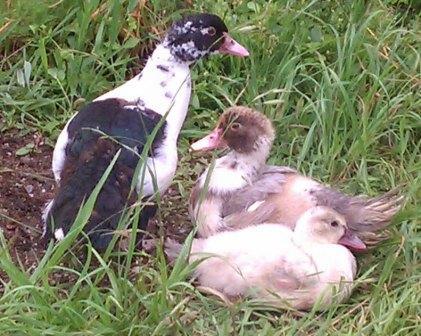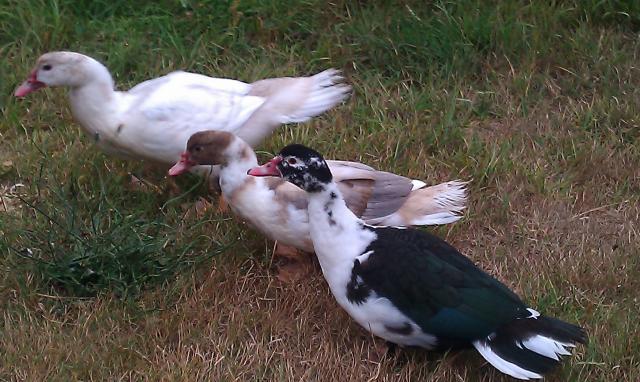- Thread starter
- #11
Quote:
Quote:
Wait, what exactly is "Fawn"? I'm trying to learn the mutations in Muscovies. This is what I learned so far:
Single Mutations:
White -- incomplete dominant (split White resembles Pied)
Pied -- recessive (larger, clearer patches of white feathers than split White)
White-Head -- dominant (full white head after second year)
Blue -- incomplete dominant (one copy gives a shaded Blue, two copies gives Silver)
Chocolate -- sex-linked recessive (brown with no iridescent sheen)
Lavender -- recessive (even-colored blue-gray, darker than Silver but lighter than Blue)
Sepia -- recessive (dark brown with iridescent sheen)
Barred -- recessive (type of lacing pattern, very faded in adults, appearing mostly on belly, dark edge to feathers)
Ripple -- recessive (type of lacing pattern, light edge to feathers with dark centers, remains prominent in adults)
Combinations:
Blue-Lavender = Light Lavender
Silver-Lavender = Silver Lavender
Blue-Chocolate = Lilac
Silver-Chocolate = Buff
Lavender-Chocolate = Cream
Blue-Lavender-Chocolate = Lilac Cream
Silver-Lavender-Chocolate = Buff Cream
Combinations with Sepia replacing Chocolate don't seem to have special names (which I prefer in usage over coming up with "Cream" for what's really "Lavender Chocolate")
Blue-Lavender-Sepia = Light Lavender Sepia
Silver-Lavender-Sepia = Silver Lavender Sepia
Blue-Sepia = Blue Sepia
Silver-Sepia = Silver Sepia
Lavender-Sepia = Lavender Sepia
Chocolate-Sepia = Chocolate Sepia
etc
The Pied, White-Head, split White, Barred and Ripple patterns are just added after the color.
Is "Fawn" another name for either "Lilac", "Buff", or "Cream"? Or is it another name for Blue or Lavender combining with Sepia? Or is it another mutation altogether?

Im going to have to print this out or save it.. I have a bunch of eggs and I only know the colors of one of the lines!
Quote:
Wait, what exactly is "Fawn"? I'm trying to learn the mutations in Muscovies. This is what I learned so far:
Single Mutations:
White -- incomplete dominant (split White resembles Pied)
Pied -- recessive (larger, clearer patches of white feathers than split White)
White-Head -- dominant (full white head after second year)
Blue -- incomplete dominant (one copy gives a shaded Blue, two copies gives Silver)
Chocolate -- sex-linked recessive (brown with no iridescent sheen)
Lavender -- recessive (even-colored blue-gray, darker than Silver but lighter than Blue)
Sepia -- recessive (dark brown with iridescent sheen)
Barred -- recessive (type of lacing pattern, very faded in adults, appearing mostly on belly, dark edge to feathers)
Ripple -- recessive (type of lacing pattern, light edge to feathers with dark centers, remains prominent in adults)
Combinations:
Blue-Lavender = Light Lavender
Silver-Lavender = Silver Lavender
Blue-Chocolate = Lilac
Silver-Chocolate = Buff
Lavender-Chocolate = Cream
Blue-Lavender-Chocolate = Lilac Cream
Silver-Lavender-Chocolate = Buff Cream
Combinations with Sepia replacing Chocolate don't seem to have special names (which I prefer in usage over coming up with "Cream" for what's really "Lavender Chocolate")
Blue-Lavender-Sepia = Light Lavender Sepia
Silver-Lavender-Sepia = Silver Lavender Sepia
Blue-Sepia = Blue Sepia
Silver-Sepia = Silver Sepia
Lavender-Sepia = Lavender Sepia
Chocolate-Sepia = Chocolate Sepia
etc
The Pied, White-Head, split White, Barred and Ripple patterns are just added after the color.
Is "Fawn" another name for either "Lilac", "Buff", or "Cream"? Or is it another name for Blue or Lavender combining with Sepia? Or is it another mutation altogether?

Im going to have to print this out or save it.. I have a bunch of eggs and I only know the colors of one of the lines!










